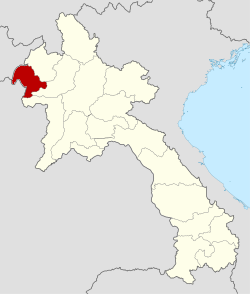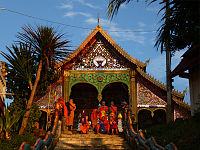Bokeo province
Bokeo province
ແຂວງ ບໍ່ແກ້ວ | |
|---|---|
 | |
 Map of Bokeo province | |
 Location of Bokeo province in Laos | |
| Coordinates:20°18′00″N100°25′01″E/ 20.3°N 100.417°E | |
| Country | Laos |
| Capital | Ban Houayxay |
| Area | |
| • Total | 6,196 km2(2,392 sq mi) |
| Population (2020 census) | |
| • Total | 203,468 |
| • Density | 33/km2(85/sq mi) |
| Time zone | UTC+7(ICT) |
| ISO 3166 code | LA-BK |
| HDI(2017) | 0.557[1] medium·13th |
Bokeo(Lao:ບໍ່ແກ້ວ,pronounced[bɔ̄ːkɛ̂ːw];literally 'gem mine'; previously,Hua Khong,meaning 'head of the Mekong')[2]is a northernprovinceofLaos.It is the smallest and second least populous province in the country.[3]Bokeo province covers an area of 6,196 square kilometres (2,392 sq mi). Bokeo province bordersLuang Namtha provinceto the northeast,Oudomxai provinceto the east,Xaignabouli provinceto the south, andThailandto the southwest andBurmato the west and northwest. The province has five districts: (Houay Xay,Tonpheung,Meung,Phaodom,andPaktha) and theGolden Triangle Special Economic ZoneinTon Pheung district.It is rich in deposits of precious and semiprecious stones.[citation needed]Bokeo's provincial capital isHouayxayon theMekong River.The province is in theGolden Triangle,at the border ofMyanmarandThailand.[4]There are 34 ethnic groups in the province.Houay Xayis a border town with Thailand and regional economic centre.[citation needed]
History
[edit]Bokeo was named after thesapphiresmined inHouayxayDistrict.[5]Astelethat is dated 1458 is found in theWat Jom KaoManilat, apagodabuilt in 1880 ofteakinShan architectural style.Fort Carnot,a historical artifact of theFrench colonial empire,now belongs to the Lao Army.[4]
The province was created in 1983, when it was split off fromLuang Namtha province.In 1992,PakthaandPha Oudom Districtswere reassigned fromOudomxay province.[6]In the past, Houayxay town was a marked crossroad trading centre betweenYunnan provinceof China and Thailand, particularly for Chinese goods.[4]
Geography
[edit]Bokeo province is the smallest of the country's provinces,[7]covering an area of 6,196 square kilometres (2,392 sq mi).[8]Bokeo province bordersLuang Namtha provinceto the northeast,Oudomxay provinceto the east,Sainyabuli provinceto the south,Thailandto the southwest, andBurmato the west and northwest.[citation needed]Notable settlements includeHouayxay,Mong Lin,Ban Thakate,Ban Meung Hong,Ban Ha Li Tai,Ban Khai San,Ban Nam Kueng,Ban LongandBan Paung.TheNam Nga Riverflows through the province'sBokeo Nature Reserve,[9]and is hemmed between the Mekong River bordering Thailand and Burma and is also on the trade route withChina.[3]Don Saois an island in Tonpheung District, which is connected to the mainland except during the rainy season.[10]
Protected areas
[edit]TheBokeo Nature Reservewas created as protection for theblack crested gibbon(also known as "black-cheeked gibbon" ), discovered in 1997, previously thought to be extinct.Elephantsandwild water buffalomigrate through the reserve;[11]bearsandtigersare also present.[12]Theprotected area,is characterized by a mixed deciduous forest and mountainous terrain (elevation ranging between 500 and 1500 m).[9]The area covered by the reserve is 136,000 hectares (336,000 acres), including 66,000 hectares (163,000 acres) in Bokeo province and 70,000 hectares (173,000 acres) in Luang Namtha province where critically endangered species ofwestern black crested gibbon(Nomascus concolor) is the primary protected species. According to a preliminary survey, the number of gibbons is substantial, particularly in and around the uninhabited Nam Kan River and its tributaries. The project is being supported by the French entrepreneur Jean Francois Reumaux as a Gibbon Experience Project.[13]Gibbon Experience is a conservation project that came into existence after the indigenous black-cheeked gibbon was discovered. The conservation programme has two components: one is ofgibbonviewing huts, known as canopy huts (there are four such very large huts) in the forest reserve meant to view the black cheeked gibbons and the second component is to experience the rain forest at canopy level. The Waterfall Gibbon Experience involves three hours of hiking to the location, deep in the reserve following the Nam Nga River.[9]
Other than gibbons, wildlife in the reserve reported are:great barbet(Megalaima virens);grey-headed parakeet(Psittacula finschii);grey leaf monkeys(Semnopithecus);crab-eating mongoose(Herpestes urva),tiger(Panthera tigris); smaller cats;dhole(Cuon alpinus), bears (two types);otters;sambar(Cervus unicolor); and wild cattle (gaur).[13]
The 10,980 hectare Upper Lao MekongImportant Bird Area(IBA) stretches across the provinces of Bokeo, Oudomxay, and Sainyabuli. It is at an elevation of 300–400 metres (980–1,310 ft). The topography features river channels, exposed beds, sandbars, sand and gravel bars, islands, rock outcrops, bushland, and braided streams. Confirmed avifauna includeblack-bellied tern(Sterna acuticauda),great cormorant(Phalacrocorax carbo),grey-headed lapwing(Vanellus cinereus),Jerdon's bush chat(Saxicola jerdoni),brown-throated martin(Riparia paludicola),river lapwing(Vanellus duvaucelii),small pratincole(Glareola lactea), andswan goose(Anser cygnoides).[14]
Administrative divisions
[edit]The province includes the following districts:[4]
| Map | Code | Name | Lao script | Population (2015) |
|---|---|---|---|---|

| ||||
| 5-01 | Houayxay | ເມືອງຫ້ວຍຊາຍ | 70,170 | |
| 5–02 | Ton Pheung | ເມືອງຕົ້ນເຜິ້ງ | 34,476 | |
| 5–03 | Meung | ເມືອງເມິງ | 14,506 | |
| 5–04 | Pha Oudom | ເມືອງຜາອຸດົມ | 40,909 | |
| 5–05 | Pak Tha | ເມືອງປາກທາ | 19,182 |
Demographics
[edit]Its population was 179,243 in 2015,[15]in 36 townships, and more than 400 villages.[4]With 34 ethnic groups (including Akha, Hmong, Khamu, Kalom, Kui, Lamet, Lao Huay, Mien, Musoe, Ngo, Phai, Phu Thai, Phuan, Phuvan, Samtao, Shan, Tahoy, Thai Daeng, Thai Dam, Thai Khao, Thai Lu, Thai Nai, and Chinese), the province's ethnic diversity is ranked second in the country,[citation needed]afterLuang Namtha province.[2]Most numerous though are the Lanten, Hmong, Lahu, Yao, Akha, and Tai Lue peoples.[16]The Lahu, a Tibeto-Burman speaking people who are part of ethnic group of northern Myanmar and Thailand also inhabit this province in large numbers.[4]
Economy
[edit]The provincial economy is now dominated by theGolden Triangle Special Economic Zone(GT SEZ).[17]In 2007, Kings Romans Group, owned by well-connected Chinese husband and wifeZhao Weiand Su Guiqin, entered into a 99-year lease for 10,000 hectares on the banks of the Mekong.[17]The company was granted 3,000 of these hectares as a duty-free zone, now the SEZ. As gambling is illegal in China, and the SEZ is only a two-hour journey by road from China, casinos and hotels catering to a Chinese clientele were built.[18]A robust industry involving trafficking in endangered animals has grown up around the Chinese tourist trade.[19]In January 2018, theUS Treasury Departmentannounced sanctions against what it called Zhao's transnational criminal organisation, engaging in illicit activities, including human trafficking and child prostitution, drug trafficking and wildlife trafficking.[17]
- See main page atGolden Triangle Special Economic Zone
Houayxay, the capital city of the province, has most of the remainder of the province's economic activity.[3]The province is one of the mainmaizeproducing areas of Laos.[20]Commercial mining for precious stones and gold is a major economic activity.[4]Ban Nam KhokandBan Houi Sala,about 6 kilometres (3.7 mi) and 18 kilometres (11 mi) from Bokeo town respectively, are notable mining areas.[8]Buhae Industrial Corp., which mines forsapphires,is a major company operating in Houayxay District.[21]Many of the ethnic Lantaen villages are noted for their production of traditionalsaapaper and other crafts.[16]
Paa beuk,acatfish,the largest freshwater fish in the world, is found in the Mekong River. It grows to 3 metres (9.8 ft) in length and could weigh up to 300 kg. It is an economic resource as it commands a high market price. The flesh of this endangered fish is considered a delicacy.[4]
Landmarks
[edit]There are several temples in the capital city of Houayxay, including Wat Chamkao Manilat,[citation needed]Wat Jom Khao Manilat (constructed in 1880), Wat Thadsuvanna Pkakham (with eight gilded Buddhas), Wat Khonekeo Xaiyaram (with red, gold, and green doors and pillars), and Wat Keophone Savanthanaram (with a reclining Buddha behind chicken wire)[5]The buildings and barracks of the old FrenchFort Carnotare now destroyed.[5]
Gallery
[edit]-
Houayxay centre
-
Wat Jom Khao Manilat
-
Village on the Mekong River
-
In a Khmu village
References
[edit]- ^"Sub-national HDI – Area Database – Global Data Lab".hdi.globaldatalab.org.Retrieved2018-09-13.
- ^abBurke & Vaisutis 2007,p. 214.
- ^abc"Introducing Bokeo Province".Lonely Planet/BBC Worldwide.Archived fromthe originalon 2015-10-07.Retrieved30 November2012.
- ^abcdefgh"Bokeo Province: Overview".Laos Tourism Organization.Archived fromthe originalon 22 July 2015.Retrieved6 December2012.
- ^abcBush, Elliot & Ray 2010,p. 172.
- ^Levinson & Christensen 2002,p. 304.
- ^"Home".Regions.Official website of Laos Tourism. Archived fromthe originalon 11 January 2013.Retrieved7 January2013.
- ^ab"Bokeo Province".Lao Tourism. Archived fromthe originalon 9 January 2013.Retrieved1 December2012.
- ^abcWhite 2010,p. 290.
- ^Burton 2005,p. 149.
- ^DK Publishing 2011,p. 183.
- ^Outlook Publishing 2008,p. 58.
- ^ab"A scoping mission to Nam Kan National Protected Area, Lao PDR"(PDF).Arcus Foundation: Flora and Fauna International. Archived fromthe original(pdf)on 12 January 2011.Retrieved7 December2012.
- ^"Important Bird Areas factsheet: Upper Lao Mekong".BirdLife International. 2012.Retrieved7 December2012.
- ^"Results of Population and Housing Census 2015"(PDF).Lao Statistics Bureau.Retrieved1 May2020.
- ^abThe Lao National Tourism Administration."Bokeo province".Ecotourism Laos.GMS Sustainable Tourism Development Project in Lao PDR. Archived fromthe originalon 29 August 2012.Retrieved1 December2012.
- ^abcParry, Simon (14 April 2018)."A Mr Big of wildlife trafficking: could elusive Laos casino operator be behind rackets that run to drugs, child prostitution?".South China Morning Post.Retrieved23 December2020.
- ^Hance, Jeremy (2015-03-19)."High-end Laos resort serves up illegal wildlife for Chinese tourists".The Guardian.Retrieved20 Mar2015.
- ^Sin City Illegal Wildlife Trade in Laos' Golden Triangle Special Economic Zone(PDF).London: Environmental Investigation Agency (EIA). March 2015.
- ^Lao People's Democratic Republic: Second Poverty Reduction Strategy Paper (EPub).International Monetary Fund. 21 October 2008. p. 54.ISBN978-1-4527-9182-1.Retrieved6 December2012.
- ^Geological Survey (US) 2010,p. 14.
Sources
[edit]- Burke, Andrew; Vaisutis, Justine (1 August 2007).Laos 6th Edition.Lonely Planet. pp. 214–.ISBN978-1-74104-568-0.
- Bush, Austin; Elliot, Mark; Ray, Nick (1 December 2010).Laos 7.Lonely Planet. pp. 172–.ISBN978-1-74179-153-2.
- Burton, John J. S. (2005).Lao close encounters.Orchid Press. p. 149.ISBN978-974-524-075-9.Retrieved4 December2012.
- DK Publishing (1 July 2011).DK Eyewitness Travel Guide: Cambodia & Laos: Cambodia & Laos.Penguin. pp. 183–.ISBN978-0-7566-8426-6.
- Geological Survey (US) (25 October 2010).Minerals Yearbook: Area Reports: International 2008: Asia and the Pacific.Government Printing Office. pp. 14–.ISBN978-1-4113-2964-5.
- Levinson, David; Christensen, Karen (2002).Encyclopedia of modern Asia.Charles Scribner's Sons. p. 304.ISBN978-0-684-31242-2.
- Outlook Publishing (March 2008).Outlook Traveller.Outlook Publishing. pp. 58–.
- White, Daniel (1 March 2010).Frommer's Cambodia and Laos.John Wiley & Sons. pp. 290–.ISBN978-0-470-49778-4.




